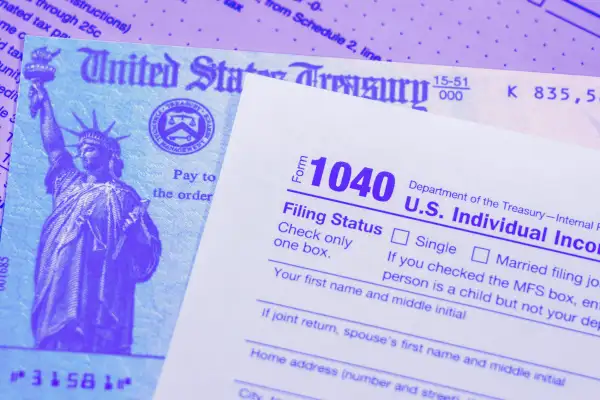It's Not Too Late to Qualify for a Stimulus Check — or Increase the Amount You Get

Third stimulus checks have started hitting Americans' bank accounts, following President Joe Biden’s signing of the $1.9 trillion American Rescue Plan last week. Some recipients got their direct deposit as early as March 12, according to the IRS, and many will see theirs arrive by March 17.
Your eligibility for a stimulus check of up to $1,400 is based on your income as reported on the most recent tax return that the IRS has on file for you, whether that's 2019 or, if you've already filed it, 2020.
If you haven't filed your 2020 return yet and it looks like your income for the year is just above the eligibility cutoff, there are steps you can take to lower it (legally, of course) and increase your chances of getting a check later this year, thanks to a look-back provision in the new stimulus law. Bonus? These moves are good for your financial health.
Here's how to lower your adjusted gross income and increase your chances for a third stimulus check (or, if you've already received the payment, a bigger one).
How much can you make to qualify for a stimulus check?
Individuals are eligible to get the full $1,400 check with an adjusted gross income (AGI) of $75,000 or less, and $112,500 or less for heads of households. Married couples with an AGI of $150,000 or less will get $2,800 (plus checks for any eligible dependents). Like the previous stimulus checks, the amount will start to phase down if you have a higher AGI. This time, the income cap to receive any stimulus check at all is lower than the first two rounds: individuals who earn more than $80,000, heads of households who earn more than $120,000 and married couples who earn more than $160,000 will not receive any payment.
How to lower your adjusted gross income for 2020 now
Your AGI is taxable income minus selected deductions.
One way to lower your AGI is by contributing to a traditional individual retirement account (IRA), says Harvey Bezozi, a certified public accountant and founder of YourFinancialWizard.com. You can contribute to your IRA for 2020 by April 15, 2021 (just make sure to note that the contribution is for last year, or your brokerage firm may apply it to this year). For 2020, you can contribute up to $6,000 to your IRA, or $7,000 if you’re 50 or older. (Contributing to a retirement account now also means you’re taking advantage of compound interest even sooner — it’s a win-win.)
If you haven't already filed your 2020 return, the law includes a look-back provision that will capture your 2020 income after you file. This "additional payment determination date” will fall either 90 days after the tax filing deadline or Sept. 1. If you receive a lower payment — or no payment — based on your 2019 return, but are eligible for more money based on your 2020 return, you may get what you're owed through this process, says Garrett Watson, a senior policy analyst at the Tax Foundation.
Here's where lowering your taxable income now could make sense: Say you made $80,000 in 2020, but contribute $6,000 to traditional IRA, your AGI would fall to $74,000, making you eligible for a full stimulus payment, Bezozi says.
Keep in mind that Roth IRAs are not deductible, since they’re funded by after-tax dollars, so contributing to one now won’t lower your AGI. And contributions to 401(k)s typically need to be made by the end of the year.
Another option is putting money into a health savings account (HSA), says Eric Bronnenkant, Head of Tax at Betterment. These accounts, which you can qualify for if you’re enrolled in a high-deductible health plan, allow you to set aside tax-free money for qualified medical expenses. They also allow retroactive contributions for the prior year by the tax deadline of April 15. Even if your employer doesn’t offer one along with your health insurance plan, you can open one via a financial institution like Fidelity Investments if you qualify.
HSAs are triple-tax advantaged in that — in addition to allowing you to make tax-deductible contributions — they let you accrue tax-free earnings and make tax-free withdrawals for qualified medical expenses. If you don’t use the money, it will rollover to the next year.
But what if you already filed your 2020 return and still want to contribute to an IRA or HSA for 2020 to increase your stimulus eligibility? It's unclear how this look-back would work if you make a 2020 contribution to a traditional IRA by April 15, for example, and file an amended return to update your already filed 2020 return.
How your 2021 adjusted gross income could lead to a bigger stimulus check next year
Since the third stimulus checks are a 2021 Recovery Rebate Credit, if your income is lower in 2021 than in 2020 or 2019 — making you eligible for a stimulus payment or a bigger stimulus payment — you can claim the correct payment when you file your 2021 taxes next year. This also applies for other changes in circumstances, like if you had a child. It's unclear exactly when or how people would receive these payments. The IRS hasn’t responded to Money’s request for comment on how the agency will handle these additional payments, or if the agency will look at amended 2020 returns at the "additional payment determination date.”
Even if you can't lower your way to a third stimulus check, reducing your AGI still generally results in a smaller tax bill. And you've set away funds for the future. Unless the tax deadline gets pushed back, you have until April 15.
More from Money:
New Stimulus Law Erases a Big Student Loan Forgiveness Catch
The New Stimulus Bill Includes Monthly Payments to Millions of Parents. Here's How It Works
